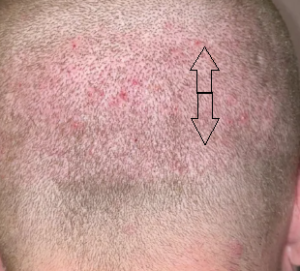can you show me a proper FUE donor area? (photo)
Can you predict a final hair loss pattern?
Is it true that a trained doctor or professional can predict an someone final hair loss pattern?
Not 100%, however using family history, timing your appearance of balding (when you started), how fast it is moving, miniaturization analysis and most important if you have a significant amount of hair get a HAIRCHECK test (https://baldingblog.com/haircheck-test-how-it-is-done-video/), then I might be reasonably confident I could advise you on your final balding pattern, especially if you are over 25 years of age.
2020-03-27 03:40:252020-03-27 09:52:12Can you predict a final hair loss pattern?
Can You Place Grafts Between Growing Full Hairs?
Dear Doctor Rassman,
I have very full hair on my head, pretty long, but the forehead starts getting lighter. Also in between I do not like that it starts shining through and becomes thinner. Is there a chance even to put grafts in between of the growing full hair just to make the appearance even fuller? Also I would like to think about working on the receding hairline.I appreciate your coming back to me and remain with kindest regards
It is hard to answer your question, because I do not know what you are seeing. If you get your hair mapped out for miniaturization we might know what it is that you are seeing. Is this the early stages of thinning genetic hair loss? Without quantifying the miniaturization, I can not help you.
Generally, placing transplanted hair next to healthy hair does little damage, but it is possible that you could damage any hairs that are miniaturizing. Most people do not ask for more thickness if they have their normal hair with its full bulk present, so I am going to assume that you are miniaturizing in the area you want to thicken up, which would change my answer to your question as yes, your miniaturized hair can be permanently damaged from a transplant that is done without regard to a proper Master Plan for your hair loss.
We commonly see hair transplants done in “normal” hair areas. This occurs when a doctor ‘sells’ a transplant to make money and places transplants on the entire head when only a part of the head is bald. Unfortunately, I see this done too often, even in Los Angeles. The other day, I had a patient come to see me who maybe needed 800 grafts, but he was sold over 3000 grafts at another clinic, which was transplanted over a year ago. To make matters worse, of the 800 that should have been placed in the frontal hairline to thicken it, less than half of that number grew there. The other 2200+ grafts were put into other parts of his normal scalp. Other than the loss of his money charged for the unnecessary surgery, there was no damage to the normal transplanted hair throughout his head. Again, my motto is: Let the Buyer Beware!
2007-03-26 15:31:342007-03-26 18:37:02Can You Place Grafts Between Growing Full Hairs?
Can you share a patient’s experience with SMP?
Go to https://scalpmicropigmentation.com/ and go down to the second man on the front page which has a video where the man tells his very interesting and funny story about his experience with Scalp Micropigmentation (SMP).
2019-11-08 08:45:162019-11-08 08:45:16Can you share a patient’s experience with SMP?
Can You Transplant Hair from a Cadaver onto a Live Person?
No way! Hair is an organ, and therefore transplants from another person will always reject, alive or dead!
2020-04-10 04:00:452020-04-19 09:40:38Can You Transplant Hair from a Cadaver onto a Live Person?
Can you thicken miniaturized hairs?
I had diffuse thinning for 2 years, and now my hair is suddenly regrowing, will miniaturized hairs on right side of my hairline get thicker?
Miniaturization in genetic hair loss reflects an early stage of hair loss. Miniaturized hairs can be seen in various stages of miniaturization. For example your normal hair shaft is 70 microns in thickness, a miniaturized hair could be any thickness less than 50-60 microns on any particular individual. So in the earliest stage of hair loss, it might be 50 microns in thickness and over time come down to 40, then 30, then 20 microns and at some point it might just be like a tread with almost no thickness to it at all. All of these are miniaturized hairs. When people take the drug finasteride, it often reverses the degree of miniaturization such that a 30 micron hair thickness which is less than 50% of its original value, may thicken to 90% or at times 100% of its original value. That is why I like finasteride as it works both to reverse miniaturization and to stop the hairs from both miniaturizing and falling out directly (another manifestation of hair loss).
2020-07-10 03:32:102020-07-10 07:23:34Can you thicken miniaturized hairs?
Can You Tell Me What to Do About My Hair Loss?
I would want to know your age, your family history and what you have done so far to treat it. You need a doctor. I make myself available on-line here: https://newhair.com/doctors/rassman/
2020-05-08 04:00:292020-05-04 12:55:15Can You Tell Me What to Do About My Hair Loss?
Can You Take Finasteride Propecia for Diffuse Patterned Alopecia (DPA)?
1. Have DPA young patients (Early 20´s) more oportunities with finasteride in comparasion with a MBP who have a normal patron (NW 6).
2. Have you ever seen a early 20´s with DPA who have a good response to finasteride for a long time (10 years)?I am a 21 years old and I have taken finasteride since I was 18 years.. My dermatologist prescribed it to me.
Here you have photos of mine when I start the treatment (2012) and now
(2014).
Diffuse Pattern Alopecia (DPA) is basically the same as Male Pattern Balding otherwise known as Androgenic Alopecia. DPA, as the term implies, shows up as diffuse hair loss that occur in a “pattern” such as you see in male pattern balding but the permanent zone on the back and side of your head not impacted.
Finasteride (Propecia) is used for the treatment of this condition (DPA, AGA, MPB – they are all the same).
There is another condition called Diffuse Unpatterned Alopecia (DUPA), which may be genetic, but does not respond to the drug finasteride (Propecia). DUPA is uncommon; however, it is critical to have your doctor make this diagnosis before being considered a candidate for hair transplant or medication. These DUPA male patients often get a failure of the transplant, even if on the drug finasteride.
I cannot make a diagnosis with your photo and this blog is not a place for making diagnosis. I also cannot predict what will happen in 10 years. I am not a fortune teller. I have seen men in their early 20’s start finasteride for male pattern balding and has kept most of their hair. I have also seen them lose their hair rapidly despite being on finasteride as their genetic predisposition overtook the drugs ability to slow things down. It doesn’t mean that the drug didn’t work.
Can Zinc Cause Hair Loss From Increased Testosterone?
I get oily skin and increased libido while on zinc 50mg/day. As Zinc increases testosterone so I fear that it may increase the progression rate of my baldness. Considering that I’m also on Finasteride, will the use of zinc negatively affect my hair?
The short answer to your question is that zinc does not necessarily negatively affect hair loss. Some studies show zinc supplements increase testosterone levels.
There are other studies that show zinc supplements do NOT affect testosterone levels.
For a normal healthy individual with genetic male pattern balding (MPB) taking over the counter supplements such as zinc would not negatively or positively affect their hair loss. It is always a good idea to follow up with your doctor if you have concerns.



